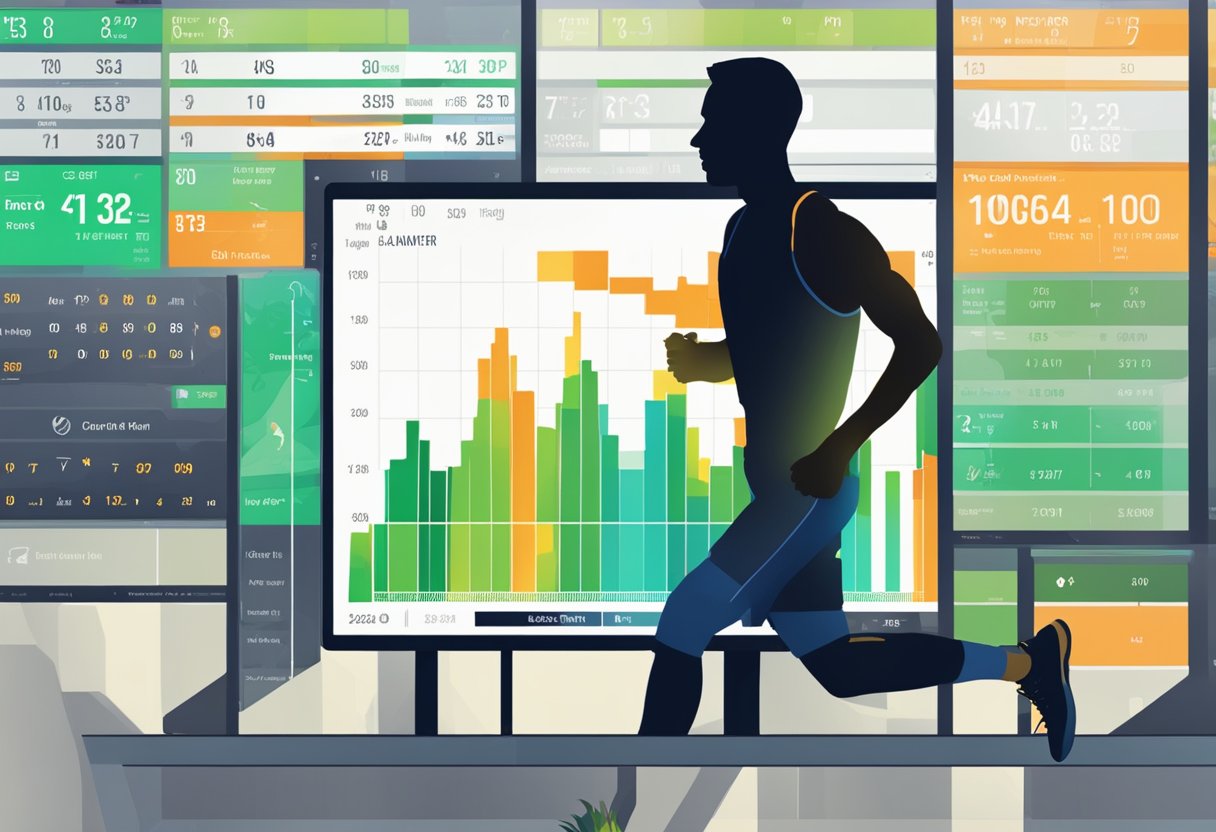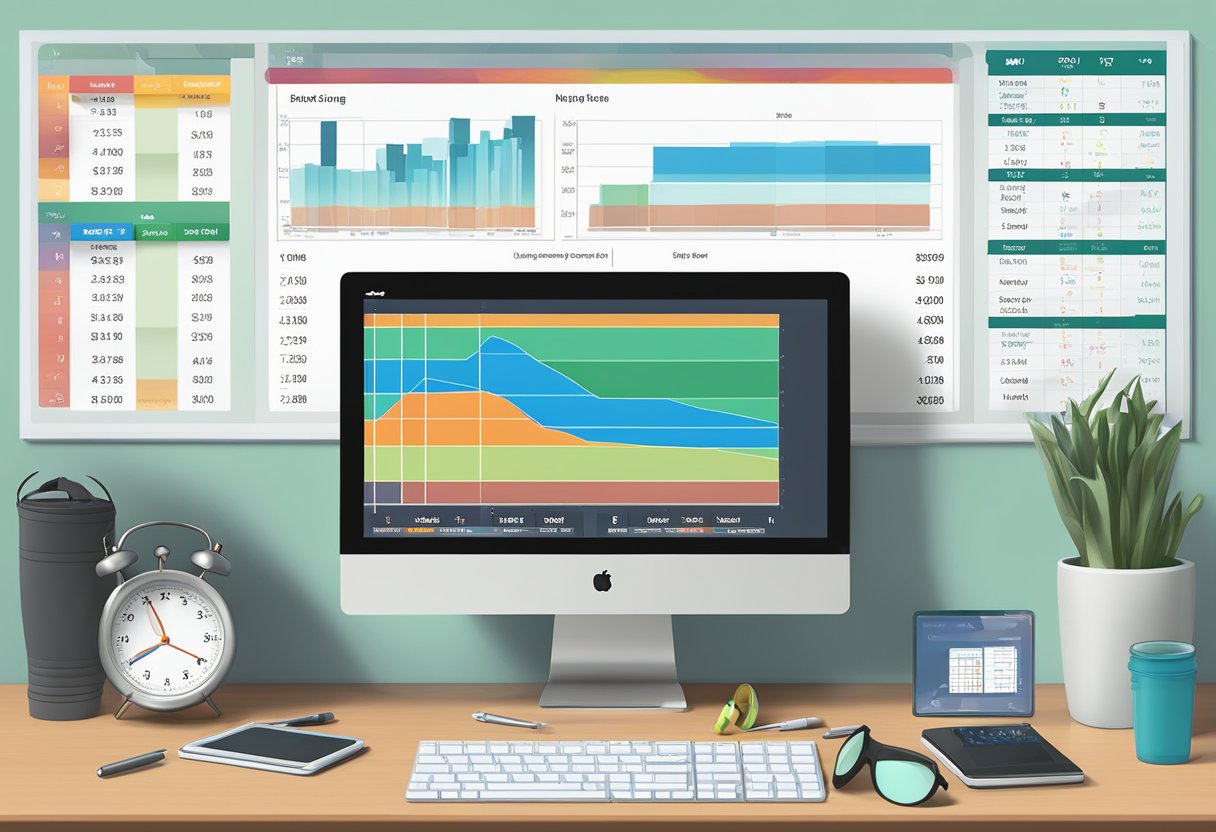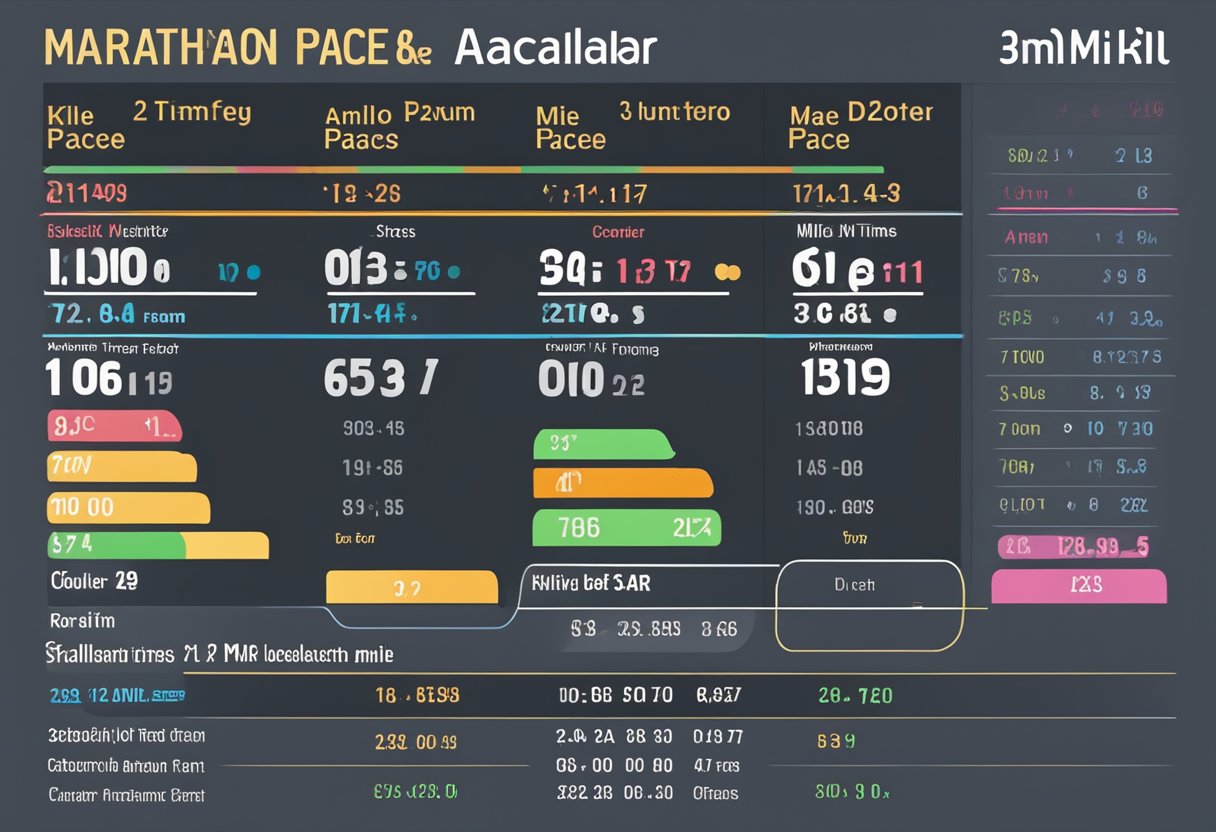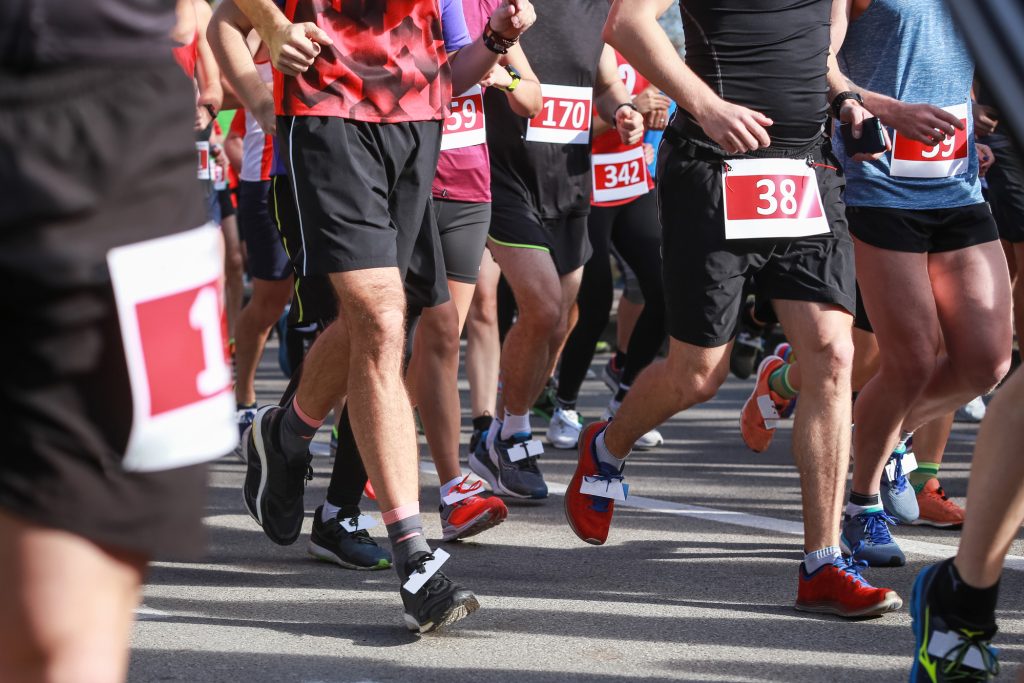When preparing for a marathon race, understanding and utilizing a marathon pace calculator chart is crucial for a successful finish.
Knowing your desired finish time and breaking it down into achievable splits per mile or kilometer can help you maintain a steady pace from the starting line to the end.
This strategy avoids the common pitfall of starting too fast and losing energy prematurely.
A marathon pace chart serves as a guide, helping you create a race strategy tailored to your personal goals and endurance levels.
| Average Pace | 5K | 5 Miles | 10K | 10 Miles | 13.1M Half | 25K | 26.2 Marathon |
| 4:40 | 14:32 | 23:20 | 29:04 | 46:40 | 1:01:10 | 1:12:30 | 2:02:21 |
| 4:45 | 14:47 | 23:45 | 29:35 | 47:30 | 1:02:16 | 1:13:47 | 2:04:32 |
| 5:00 | 15:34 | 25:00 | 31:08 | 50:00 | 1:05:33 | 1:17:40 | 2:11:06 |
| 5:15 | 16:20 | 26:15 | 32:41 | 52:30 | 1:08:49 | 1:21:33 | 2:17:39 |
| 5:30 | 17:07 | 27:30 | 34:14 | 55:00 | 1:12:06 | 1:25:26 | 2:24:12 |
| 5:45 | 17:53 | 28:45 | 35:47 | 57:30 | 1:15:22 | 1:29:19 | 2:30:45 |
| 6:00 | 18:40 | 30:00 | 37:20 | 1:00:00 | 1:18:39 | 1:33:12 | 2:37:19 |
| 6:15 | 19:26 | 31:15 | 38:53 | 1:02:30 | 1:21:56 | 1:37:05 | 2:43:52 |
| 6:30 | 20:13 | 32:30 | 40:26 | 1:05:00 | 1:25:12 | 1:40:58 | 2:50:25 |
| 6:45 | 20:59 | 33:45 | 41:59 | 1:07:30 | 1:28:29 | 1:44:51 | 2:56:59 |
| 7:00 | 21:46 | 35:00 | 43:32 | 1:10:00 | 1:31:46 | 1:48:44 | 3:03:32 |
| 7:15 | 22:32 | 36:15 | 45:05 | 1:12:30 | 1:35:02 | 1:52:37 | 3:10:05 |
| 7:30 | 23:19 | 37:30 | 46:38 | 1:15:00 | 1:38:19 | 1:56:30 | 3:16:39 |
| 7:45 | 24:15 | 38:45 | 48:11 | 1:17:30 | 1:41:36 | 2:00:23 | 3:23:12 |
| 8:00 | 24:52 | 40:00 | 49:44 | 1:20:30 | 1:44:52 | 2:04:16 | 3:29:45 |
| 8:15 | 25:38 | 41:15 | 51:17 | 1:22:30 | 1:48:09 | 2:08:09 | 3:36:18 |
| 8:30 | 26:25 | 42:30 | 52:50 | 1:25:00 | 1:51:26 | 2:12:02 | 3:42:52 |
| 8:45 | 27:11 | 43:45 | 54:23 | 1:27:30 | 1:54:42 | 2:15:55 | 3:49:25 |
| 9:00 | 27:58 | 45:00 | 55:56 | 1:30:00 | 1:57:59 | 2:19:52 | 3:55:58 |
| 9:15 | 28:44 | 46:15 | 57:29 | 1:32:30 | 2:01:16 | 2:23:52 | 4:02:32 |
| 9:30 | 29:31 | 47:30 | 59:02 | 1:35:00 | 2:04:32 | 2:27:35 | 4:09:05 |
| 9:45 | 30:04 | 48:45 | 1:00:35 | 1:37:30 | 2:07:49 | 2:31:28 | 4:15:38 |
| 10:00 | 31:04 | 50:00 | 1:02:09 | 1:40:00 | 2:11:06 | 2:35:21 | 4:22:12 |
| 10:15 | 31:51 | 51:15 | 1:03:42 | 1:42:30 | 2:14:22 | 2:39:14 | 4:28:45 |
| 10:30 | 32:37 | 52:30 | 1:05:15 | 1:45:00 | 2:17:39 | 2:43:07 | 4:35:18 |
| 10:45 | 33:24 | 53:45 | 1:06:48 | 1:47:30 | 2:20:55 | 2:47:00 | 4:41:51 |
| 11:00 | 34:10 | 55:00 | 1:08:21 | 1:50:00 | 2:24:12 | 2:50:53 | 4:48:25 |
| 11:15 | 34:57 | 56:15 | 1:09:55 | 1:52:30 | 2:27:29 | 2:54:46 | 4:54:58 |
| 11:30 | 35:44 | 57:30 | 1:11:28 | 1:55:00 | 2:30:45 | 2:58:39 | 5:01:31 |
| 11:45 | 36:30 | 58:45 | 1:13:01 | 1:57:30 | 2:34:02 | 3:02:32 | 5:08:05 |
| 12:00 | 37:17 | 1:00:00 | 1:14:34 | 2:00:00 | 2:37:19 | 3:06:25 | 5:14:38 |
| 12:15 | 38:04 | 1:01:15 | 1:16:08 | 2:02:30 | 2:40:35 | 3:10:18 | 5:21:11 |
| 12:30 | 38:50 | 1:02:30 | 1:17:41 | 2:05:00 | 2:43:52 | 3:14:11 | 5:27:45 |
| 12:45 | 39:37 | 1:03:45 | 1:19:14 | 2:07:30 | 2:47:09 | 3:18:04 | 5:34’18 |
| 13:00 | 40:23 | 1:05:00 | 1:20:47 | 2:10:00 | 2:50:25 | 3:21:57 | 5:40:51 |
| 13:15 | 41:10 | 1:05:15 | 1:22:20 | 2:12:30 | 2:53:42 | 3:25:50 | 5:47:24 |
| 13:30 | 41:57 | 1:07:30 | 1:23:54 | 2:15:00 | 2:56:59 | 3:29:43 | 5:53:58 |
| 13:45 | 42:43 | 1:08:45 | 1:25:27 | 2:17:30 | 3:00:15 | 3:33:36 | 6:00:31 |
To use a marathon pace chart effectively, determine your marathon goal first.
This involves setting a realistic finish time based on your fitness level and previous race times.
Once your goal is set, the pace chart translates that finish time into a per-mile or per-kilometer pace.
This way, you can know exactly how fast you need to run each race segment to meet your overall time objective.
Training strategies can then be adjusted accordingly, ensuring you’re physically and mentally prepared to meet each mile with the right energy and speed.
Key Takeaways
- A marathon pace chart aligns your finish time goals with an actionable race strategy.
- Setting a realistic marathon goal is essential for effective pace chart utilization.
- Proper training strategies enhance your ability to maintain the pace chart splits on race day.
Quick Navigation
Determining Your Marathon Goal

When targeting a marathon, it’s essential to establish a goal time that’s challenging yet achievable and to fully understand what that finish time represents in terms of pace.
Setting a Realistic Target Time
Your target marathon time should reflect your running history and fitness level.
Begin by evaluating your best times from previous races, considering distances from 5K to half marathon.
Use these times to gauge the marathon pace that you could sustain.
Various tools, such as a marathon pace chart, are available online to help translate your past race performances into a potential marathon finish time.
- Evaluate past performances: Look at your previous race times to set a baseline.
- Assess training: Match your goal to the intensity and volume of your training.
- Physical readiness: Be honest about your fitness level to avoid setting an unattainable target.
Your goal finish time shouldn’t be a random choice; tailor it to reflect realistic improvements based on your training.
Understanding Marathon Finish Time
The marathon finish time represents more than just the moment you cross the finish line; it encapsulates the entire preparation journey and race day execution.
Understanding this helps set a specific time goal for variables such as course terrain, expected weather on race day, and individual health and fitness on the marathon day.
- Course specifics: Is it hilly or flat? Adjust your pace goals accordingly.
- Climate: Hot, cold, or humid conditions can affect your performance.
- Health: Consider any potential health issues that may impact your pace.
A nuanced understanding of what influences your marathon performance ensures a target finish time that is more than just attainable—it reflects your hard-earned capabilities.
Pace Calculation Tools and Techniques
When preparing for a marathon, understanding and calculating your pace is crucial.
Specialized tools and precise techniques are available to help you determine your average pace and strategize your race pace.
Using a Marathon Pace Calculator
A marathon pace calculator simplifies determining your pace for the marathon distance.
Such calculators provide a mile or kilometer split breakdown by inputting your desired finish time or average pace.
This lets you visualize your race from start to finish, helping you plan your exertion level throughout the course.
- Mile Split: Input your target marathon finish time to get each mile’s split time.
- Kilometer Pace: Alternatively, provide a kilometer pace to estimate your total finish time.
Calculators may also allow you to manipulate variables, like adjusting your speed for hills or strategizing your halfway split.
Calculating Target Pace for Training
You must establish a target pace that aligns with your marathon goals to train effectively.
Using a running pace calculator, you can determine your:
- Target Pace: The speed you aim to maintain during your marathon.
- Training Splits: Paces for various training distances to build endurance and speed.
To calculate your target pace:
- Identify your goal marathon finish time.
- Divide this time by the marathon distance to get your average pace per mile or kilometer.
- Consider your current level of fitness and adjust your training paces accordingly.
Regularly training at or near your target pace, you adapt your body to the demands of marathon racing, increasing your chances of achieving your marathon goals.
Training Strategies for Marathon Preparation

Effective marathon preparation hinges on strategically planned training runs that build endurance and speed.
Your marathon training plan should include specific workouts to condition your body for the 26.2-mile challenge ahead.
Incorporating Long Runs and Tempo Workouts
Long runs are the cornerstone of your marathon regimen, gradually increasing in distance to accustom your muscles and cardiovascular system to sustained effort.
Allocating one day each week for a long run allows your body to adapt to the physical and mental demands of extended periods of running.
Incorporating tempo runs—sustained efforts at a comfortably hard pace—into your weekly routine will help improve your lactate threshold and running economy.
Employ a marathon pace calculator chart to ascertain your optimal tempo pace, ensuring these workouts are both challenging and effective.
The Importance of Negative Splits and Pace Groups
Running negative splits, where the second half of your run is faster than the first, teaches you to manage your energy efficiently and finish strong.
Practice this technique during longer training runs to develop a sense of how to pace yourself across the marathon duration.
Joining pace groups in training or on race day can offer additional benefits such as social support and shared pacing responsibilities, making it easier to maintain a steady speed.
Many runners find that aligning with a group helps to keep their pace in check, making it less likely to start too fast and run out of energy prematurely.
Race Day Execution

Proper execution on race day is crucial to achieving your marathon goals.
Understanding how to implement your marathon race strategy and manage nutrition will impact your performance during the first and second half of the race.
Developing a Marathon Race Strategy
Your marathon race strategy should be clear in your mind.
Start by setting a goal pace based on your training, experience, and fitness level.
Break down the marathon into smaller segments, perhaps five-mile intervals, and know the splits you must hit for each.
Remember that the first half marathon should generally be run conservatively; starting slightly slower than your overall goal pace is better to prevent early fatigue.
Use a reliable marathon pace chart to familiarize yourself with the pace you must maintain throughout the race.
Strategies will differ but often involve running the second half at the same pace or slightly faster if you feel strong enough for a negative split.
This approach helps harness energy reserves efficiently for the race’s later stages.
Be mentally prepared for the tougher moments and have a plan for how to push through them.
Fueling for the Big Day
Marathon fueling starts days before the event and is a key part of your strategy:
- Pre-Race: Consume a well-balanced meal the night before and a light, carb-rich breakfast on race day.
- Keep well-hydrated in the days leading up to the marathon.
- During the Race: Plan your fueling strategy around the aid stations on the course.
- Aim to consume a sports drink or gel every 45-60 minutes to replenish electrolytes and carbohydrates.
- If you prefer solid food, practice with it during training runs to ensure it settles nicely.
Experiment with different fuel types during long training runs to discover what works best.
On race day, stick to what you’ve practiced with; it’s not the time for surprises.
Keep hydration steady, especially if conditions are warmer than anticipated, but be careful not to overdrink, as it can lead to hyponatremia.
Marathon Pace Calculator Chart: Conclusion
Mastering your marathon strategy hinges on the smart use of a marathon pace calculator chart. This tool empowers runners to craft a personalized race plan, ensuring they hit each split precisely and efficiently manage their energy. Embrace the marathon pace calculator chart to transform your training, pace yourself perfectly on race day, and cross the finish line with a sense of achievement and a personal record in sight.


